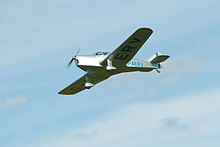Miles Whitney Straight
| M.11 Whitney Straight | |
|---|---|
 M.11A Whitney Straight (G-AEZO) after the King's Cup Race in Hatfield on September 11, 1937 |
|
| Type: | Light aircraft |
| Design country: | |
| Manufacturer: | |
| First flight: |
May 14, 1936 |
| Production time: |
1936-1937 |
| Number of pieces: |
50 |
The Miles M.11 Whitney Straight is a two-seat light aircraft from the British manufacturer Miles Aircraft , which was designed for use in flying clubs in Great Britain.
development and construction
The M.11 Whitney Straight was developed by Frederick George Miles at Phillips and Powis in collaboration with racing driver , pilot and businessman Whitney Straight . The aim was to comfortably accommodate the occupants and their luggage in a closed cockpit with seats arranged next to each other. The result was a low-wing aircraft with a rigid, aerodynamically clad tail wheel landing gear . The aircraft consists of frames made of spruce wood , which are clad with three-layer Port Orford cedar plywood , mostly made of wood. The wings have vacuum operated slotted flaps . It is powered by a de Havilland Gipsy Major I with a nominal output of 130 PS (96 kW ).
use
On 14 May 1936, the completed prototype with the air vehicle registration G-AECT controlled by Frederick Miles its maiden flight from the airfield in Woodley . When production ceased in 1937, 50 had been built.
On June 28, 1938, the M.11C with the registration G-AEYI crashed over Harefield in Berkshire . The pilot Wing Commander FW Stent was killed in the crash. Modified Whitney Straights were used for engine testing and testing of various flap designs . After the outbreak of World War II in 1939, the Air Ministry requisitioned twenty-three machines for military service as liaison aircraft . Twenty-one of these were stationed in the United Kingdom , one in India and one in Egypt . One M.11A was used by the Fleet Air Arm between 1940 and 1943 , and three more by the Royal New Zealand Air Force .
Between 1939 and 1943, Alan Pritchard used an M.11A at Ninety Mile Beach , New Zealand, for experiments with airborne seeds and later for spraying superphosphate . These attempts were part of the development of agricultural fertilizer flying.
Versions
Source: DL Brown, 1970, pp. 377-380
- M.11
- Prototype, one copy built
- M.11A
- Series version, 49 copies built.
- M.11B
- Third production copy (serial number 305), which was equipped with an Amherst Villiers Maya I with 135 HP (99 kW ). It gave the machine a 10 mph (16 km / h ) increased maximum speed and a maximum rate of climb of 200 ft / min (1 m / s).
- M.11C
- Serial production number 341 was equipped with a de Havilland Gipsy Major II with 145 HP (107 kW) and a controllable pitch propeller .
operator
- Royal Air Force
- Royal Navy
- Starways (G-AFGK)
Preserved copies
- G-AERV in England
- G-AFGK at the Reynolds-Alberta Museum in Wetaskiwin , Alberta
Technical data (M.11A)
| Parameter | Data |
|---|---|
| crew | 1 |
| Passengers | 1 |
| length | 25 ft (7.62 m ) |
| span | 35.67 ft (10.87 m) |
| height | 6.5 ft (1.98 m) |
| Wing area | 187 ft² (17.4 m² ) |
| Wing extension | 6.8 |
| Empty mass | 1,275 lb (578 kg ) |
| Max. Takeoff mass | 1,896 lb (860 kg) |
| Cruising speed | 130 mph (209 km / h ) |
| Top speed | 145 mph (233 km / h) |
| Service ceiling | 18,500 ft (5,639 m) |
| Range | 500 NM (926 km ) |
| Engines | 1 × de Havilland Gipsy Major I with 130 PS (96 kW ) |
See also
literature
- Don L. Brown: Miles Aircraft since 1925 , Putnam & Co., 1970, ISBN 0 370 00127 3 ; Pp. 121-128
- Arthur WJG Ord-Hume: British Light Airplanes - Their Evolution, Development and Perfection 1920-1940 , GMS Aviation Books, 2000, ISBN 1-870384-76-8 , pp. 421-422
- David Mondey: The Hamlyn Concise Guide to British Aircraft of World War II . Chancellor Press, 2002, ISBN 1-85152-668-4 (English).
Web links
Individual evidence
- ↑ Tom Moulson: The Millionaires' Squadron: The Remarkable Story of 601 Squadron and the Flying Sword . Pen and Sword, Barnsley, South Yorkshire 2014, ISBN 978-1-78346-339-8 , pp. 110 ff . (English, google.com ).
- ^ Martin Bowman: Lost Wings of WWI: Downed Airmen on the Western Front 1914-1918 . Pen and Sword, Barnsley, South Yorkshire 2014, ISBN 978-1-4738-4226-7 , pp. 303 ff . (English, google.com ).
- ^ A b c Don L. Brown: Miles Aircraft since 1925 . 1st edition. Putnam & Company Ltd., London 1970, ISBN 0-370-00127-3 , pp. 121-128 (English).
- ↑ a b c A. J. Jackson: British civil aircraft 1919–1972 Volume III . 2nd Edition. Putnam, London 1974, ISBN 978-0-370-10014-2 , pp. 62-65 (English).

